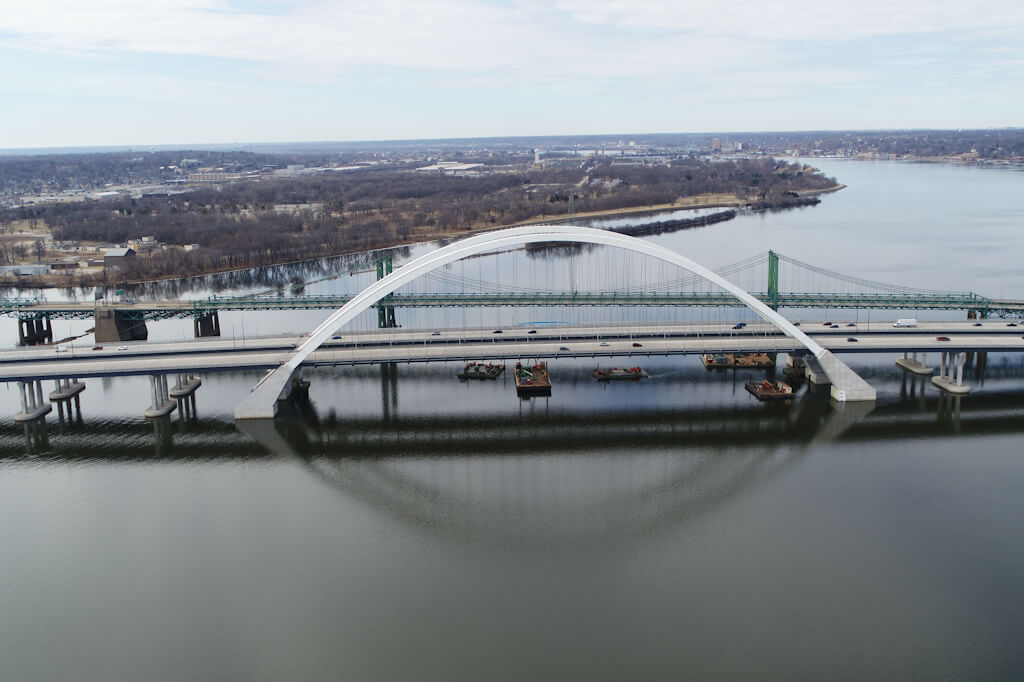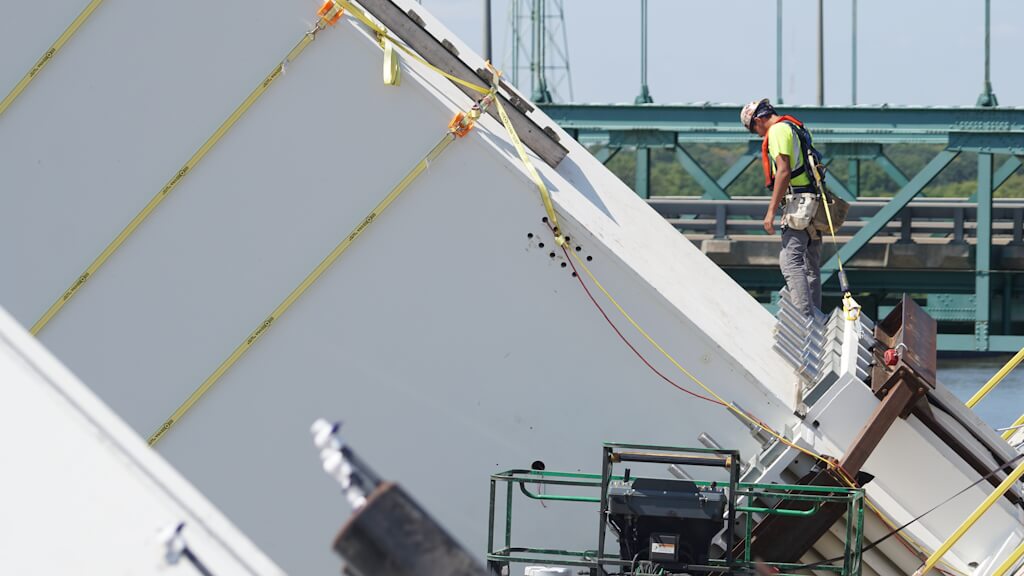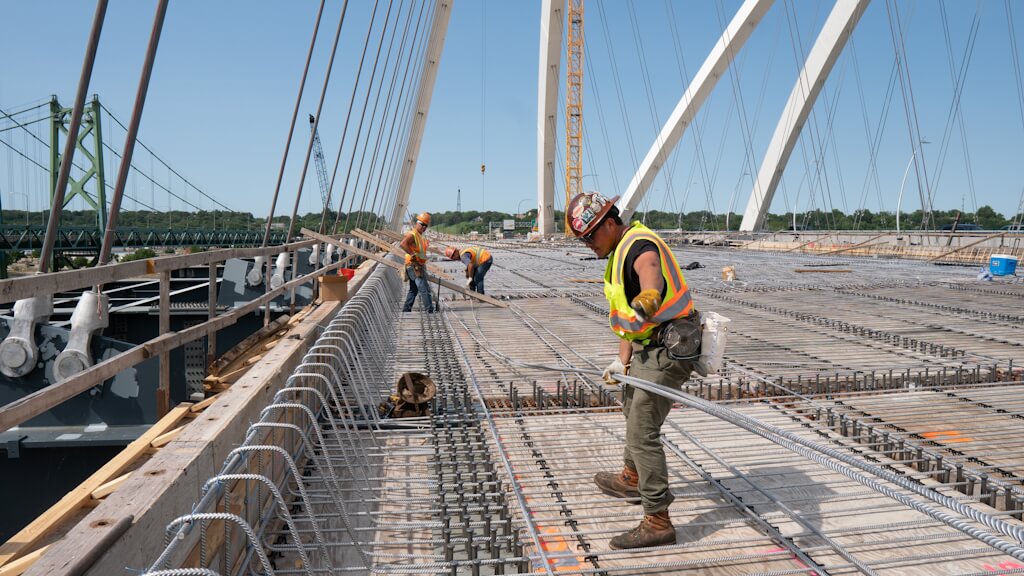Photo ©Lunda Construction Co.
Bridges influence the quality of life for an entire region by providing a way across rivers, ravines, and other obstacles. Duplex stainless steels in bridge design help avoid road closures for both replacement and maintenance. A new bridge spanning one of the world’s largest rivers uses both 2205 and 2507 duplex stainless steel for strength, longevity, and corrosion resistance.
By Karlee Williston, MolyReview Editor
The I-74 bridge, officially known as the Iowa-Illinois Memorial Bridge, lies in the cold and snowy midwestern US, about an hour east of Chicago on the Mississippi River. It’s often called the “Twin Bridges” because route I-74 runs across a pair of arch bridges, one inbound to Iowa and one into Illinois. For the people who depend on bridges for transportation, these structures signal either a sense of security or one of neglect. Fortunately, the bridges’ recent replacement involves some of the best materials available, carefully selected to last a century with minimal maintenance.
More molybdenum please
384 prestressed anchor rods made from 2507 duplex stainless steel secure the bridges’ eight arch ends to the massive reinforced concrete abutments supporting route I-74. Each bridge is designed to carry 100,000 vehicles per day. Anchor rod systems in bridges need very careful design and detailing as they are highly loaded and often exposed to very concentrated chloride salts. High concentrations of extremely corrosive deicing salts, such as the magnesium and calcium chlorides used on the I-74, combined with the cyclic loading of the highly stressed anchor rods from bridge traffic, pose a risk to structural integrity. Salt slurry can enter the crevices between the concrete slabs and bolted bar ends. Safe design must assume that the sealant in this area will fail. Extreme tensile (pulling) stress on the bar’s relatively small surface area, combined with salt exposure, can create a catastrophic combination: crevice corrosion and chloride stress corrosion cracking (CSCC) failure. Therefore, designers chose 2507 over an alloy with less molybdenum. The higher addition of molybdenum (4%) reduces the likelihood of CSCC failure by inhibiting the formation of corrosion pits.
In addition to superior corrosion resistance, Simpson, Gumpertz & Heger (SGH) structural researchers also chose 2507 duplex stainless steel for its increased strength, toughness in low temperatures, and performance under strain. With greater strength, designers were able to use fewer anchor rods with greater spacing, resulting in no cost increase to the overall project. The strength of super duplex stainless steel was just as important to the design team’s choice as its resistance to deicing salt.
Decked out with duplex
Super duplex isn’t the only stainless steel used here. The twin bridges also contain significant amounts of 2205 duplex stainless steel as rebar in the concrete abutments, bridge deck, and impact barriers. 2205 duplex stainless steel, with its 3% molybdenum, provides substantially more corrosion resistance than the carbon steel rebar used in the original bridge. Molybdenum’s ability to suppress corrosion thereby helps achieve the required 100-year service life. The I-74 bridge also convinced the jurors of the 2022 Major Span Prize Bridge Award. Organized by the American Institute of Steel Construction (AISC) and the National Steel Bridge Alliance (NSBA), this prestigious award recognizes the bridge as the winner for its creativity and innovation in design. The difference between the old and new bridges speaks for itself. At night, lavender LED lights on the new arch bridges welcome passengers over their widened thoroughfares. The bridge is also now much safer for pedestrians, who are provided with floor windows that offer views of the river below. The old bridges, narrow and peeling, were too difficult to maintain in the river with its high winds, fluctuating water levels, and frigid winters. With the mechanical properties of duplex stainless steels, a far superior piece of infrastructure now sees commuters across one of the US’s most critical arteries.
Note on deicing salt
Until recently, sodium chloride (NaCl), or “rock salt” was the only deicing salt available. Sodium chloride is effective at temperatures down to -21°C. When it gets colder, or when pretreatment for ice prevention is needed, calcium chloride (CaCl2) and magnesium chloride (MgCl2) are used, either individually or as a mixture.
These harsher salts are applied seasonally on the I-74 bridge. Cold temperatures can suppress corrosion reactions – sodium chloride does not damage surfaces unless the temperature reaches 10°C with 76% humidity. But magnesium and calcium chloride are more corrosive; they cause damage at 0°C with 45 – 50% humidity. Many bridges worldwide were constructed well before deicing became widespread in the 1960s and did not consider the effects of sodium chloride, let alone more corrosive compounds. Learn more about road salt and structural degradation in Deicing Salt – Recognizing the Corrosion Threat on IMOA’s website: https://bit.ly/deicing_salt
About IMOA
Reproduced with the kind permission of the International Molybdenum Association (IMOA). IMOA is a non-profit trade association representing the majority of the molybdenum industry worldwide. For information, visit www.imoa.info
About this Featured Story
This Featured Story appeared in Stainless Steel World January 2024 magazine. To read many more articles like these on an (almost) monthly basis, subscribe to our magazine (available in print and digital format) – SUBSCRIPTIONS TO OUR DIGITAL VERSION ARE NOW FREE.
Every week we share a new Featured Story with our Stainless Steel community. Join us and let’s share your Featured Story on Stainless Steel World online and in print.





